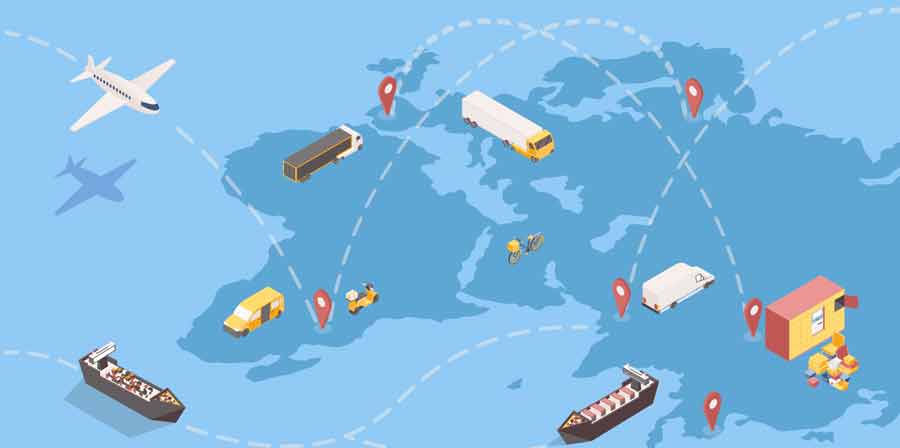Most companies like the idea of growing their business internationally, but global e-commerce is filled with challenges. Effective and affordable shipping options is a key challenge that any business looking to tackle international growth needs to solve. As a leading third-party logistics provider, we wanted to share some of the most important keys to overcoming these challenges and providing flexible delivery options for your international customers. For any business venturing into the realm of international expansion, conquering this challenge becomes paramount. At Jillamy, we are happy to share a treasure trove of insights and strategies, unlocking the most crucial secrets to overcoming these obstacles. Here is what your company needs to know about how to provide flexible delivery options for international e-commerce customers.
The Need for Flexibility in International Shipping
Imagine you're browsing your favorite online store, located halfway across the globe. You've filled your cart with items you love, but just as you're about to checkout, you're hit with limited delivery options and a list of extra costs. Frustrating, right? This is the reality for many international customers, and it's a significant reason why potential customers abandon the shopping cart and order from a different company.
A recent article published by HotJar broke down some key things to understand about shopping cart abandonment and customer expectations during the checkout process. First, international visitors are more likely to abandon shopping carts. Second, extra costs were the main reason cited for leaving a cart and ordering somewhere else. Third, estimated delivery time taking too long was also a key reason people abandoned their shopping cart. Finally, studies show that a high percentage of customers review the return policy before ordering and they will only buy if the business has a fair and customer-friendly return policy.
In the realm of international ecommerce, flexibility isn't just a buzzword – it's the cornerstone of customer satisfaction. Today's consumers anticipate a variety of shipping choices tailored to their individual preferences and way of life. Whether it's choosing a delivery time that fits their schedule, selecting a nearby pick-up point, or having the ability to redirect a package to a different address, flexibility at checkout can make or break a sale.
Moreover, this flexibility extends beyond just delivery locations and times. Customers are looking for transparent, easy-to-understand shipping costs and delivery times. They want to feel confident that their purchase will arrive safely and on time, with the option to adjust if their circumstances change.
Creating a checkout experience that showcases these flexible delivery options is crucial. It's about more than just providing choices; it's about communicating with customers in a way that assures them of a hassle-free delivery. Helping potential customers understand how much you care about this process will reduce cart abandonment rates. When customers see that an online store understands and accommodates their shipping needs, they're more likely to proceed with their purchase.
Jillamy recognizes this need and rises to the occasion. By partnering with us, businesses can offer their international customers a variety of delivery options, ensuring a smooth, worry-free shopping experience from cart to doorstep.
Diverse Delivery Locations: A Game Changer
In today's global marketplace, the one-size-fits-all approach to delivery just doesn't cut it. Customers around the world have different preferences and lifestyles, and they expect delivery options that reflect this diversity. Jillamy understands this and has revolutionized the delivery process by offering a variety of convenient and secure locations for parcel collection.
Imagine a customer in Tokyo, who works late hours and can't be home for deliveries. They can choose to have their parcel delivered to a parcel locker located at a nearby convenience store so it can be picked up after work.
Or consider a busy parent in London, who prefers not to have packages left on their doorstep. Offering the option to have that package delivered to a neighbor gives them the comfort to order online, even if they can’t be home to pick it up.
In bustling cities like New York, where space is at a premium, customers might not have a secure spot for deliveries. Local businesses, like neighborhood pack and ship stores, serving as collection hubs provide a solution to this issue. These businesses benefit from increased foot traffic, and customers enjoy the convenience of picking up their parcels while running errands.
By offering diverse options, your company is getting ahead of growing consumer demand for flexibility in timing and location of their deliveries and showing them your company is doing everything possible to meet their needs.
Tracking and Control: Empowering Customers
In the era of instant gratification, customers expect not just swift delivery but also complete visibility and control over their shipments. This demand for tracking and control is reshaping how online stores approach customer experience. Let's explore practical ways to meet these expectations without overhauling your entire online store or shopping cart system.
By implementing these strategies, online retailers can significantly enhance the customer experience, offering the tracking and control that today's shoppers expect. This strategy effectively fulfills customer needs while simultaneously bolstering brand allegiance and enhancing overall customer contentment.
-
Integrating Real-Time Tracking Solutions
- Plug-and-Play Tracking Widgets: Utilize widgets or plugins that can be easily integrated into existing ecommerce platforms. These tools provide customers with real-time tracking updates directly on your site.
- Automated Notifications: Implement automated emails or SMS notifications that update customers at key stages of the delivery process, enhancing transparency without burdening customer service resources.
- Plug-and-Play Tracking Widgets: Utilize widgets or plugins that can be easily integrated into existing ecommerce platforms. These tools provide customers with real-time tracking updates directly on your site.
-
Flexible Delivery Management
- Customer Dashboard for Delivery Options: Create a user-friendly dashboard within your website where customers can manage their delivery options. This could include the ability to change delivery addresses or reschedule delivery times.
- Third-Party App Integrations: Collaborate with third-party apps that specialize in delivery management, allowing customers to redirect their parcels to alternative locations, such as parcel lockers or local stores.
- Customer Dashboard for Delivery Options: Create a user-friendly dashboard within your website where customers can manage their delivery options. This could include the ability to change delivery addresses or reschedule delivery times.
-
Streamlining the Checkout Process
- Multiple Delivery Options at Checkout: Offer a variety of delivery choices at the point of sale, such as standard, express, and green shipping options. This array of choices addresses various customer tastes and offers a feeling of empowerment from the outset.
- Clear Communication of Delivery Terms: Ensure that delivery times, costs, and terms are clearly communicated during the checkout process. Transparency here reduces uncertainty and builds trust.
- Multiple Delivery Options at Checkout: Offer a variety of delivery choices at the point of sale, such as standard, express, and green shipping options. This array of choices addresses various customer tastes and offers a feeling of empowerment from the outset.
-
Leveraging Data for Improved Experiences
- Feedback Mechanisms: Motivate customers to share their thoughts on the delivery process. These insights are crucial for enhancing delivery choices and tracking capabilities. It is always helpful to encourage your customers to share their feedback and get requests for additional things they would like your company to support/offer.
- Delivery Performance Evaluation: Consistently assess the data on delivery efficiency to pinpoint patterns and potential enhancements. Continuous scrutiny aids in optimizing the delivery system to align more closely with customer anticipations.
- Feedback Mechanisms: Motivate customers to share their thoughts on the delivery process. These insights are crucial for enhancing delivery choices and tracking capabilities. It is always helpful to encourage your customers to share their feedback and get requests for additional things they would like your company to support/offer.
Flexible Deliveries Through Strong Partnerships
Successful global shipping goes beyond merely transporting items from one location to another; it involves mastering an intricate network of logistical challenges, compliance with various regulations, and meeting the diverse demands of customers. Strong partnerships play a pivotal role in this journey. Let's explore the types of partnerships that are most beneficial and how companies can strategically engage with them to enhance their international shipping processes.
-
Customs Clearance Partnerships
- Expertise in Local Regulations: Partnering with companies specializing in customs clearance can greatly simplify the complexities of international trade laws and regulations. These partners bring expert knowledge of local customs procedures, helping to avoid delays and penalties.
- Streamlining Cross-Border Shipments: These partners can assist in streamlining paperwork, ensuring compliance, and expediting the clearance process, thereby reducing the time shipments spend at the border.
- Expertise in Local Regulations: Partnering with companies specializing in customs clearance can greatly simplify the complexities of international trade laws and regulations. These partners bring expert knowledge of local customs procedures, helping to avoid delays and penalties.
-
Logistics and Carrier Networks
- Global Reach with Local Knowledge: Collaborating with logistics companies that have a global reach but local expertise is invaluable. Local knowledge is just hard to beat and it can provide the best advice on the most effective transportation methods and efficient routes in the area.
- Adaptable and Expandable Options: Through these collaborations, you gain access to dynamic solutions that can expand in tandem with your company's growth, guaranteeing that your logistical capabilities remain responsive to evolving requirements.
- Global Reach with Local Knowledge: Collaborating with logistics companies that have a global reach but local expertise is invaluable. Local knowledge is just hard to beat and it can provide the best advice on the most effective transportation methods and efficient routes in the area.
-
Alternative Delivery Location Providers:
- Expanding Delivery Options: A network of alternative delivery locations, such as parcel lockers or local collection points, increases flexibility for customers. Partnering with providers of these services can greatly enhance the customer experience.
- Addressing Last-Mile Challenges: These partnerships are key in solving the last-mile delivery challenge, often the most complex and costly part of the shipping process.
- Expanding Delivery Options: A network of alternative delivery locations, such as parcel lockers or local collection points, increases flexibility for customers. Partnering with providers of these services can greatly enhance the customer experience.
-
Technology and Integration Specialists
- Enhancing Tracking and Communication: Partners that offer advanced technology solutions can help integrate seamless tracking systems into your logistics, providing transparency and improving customer communication.
- Automating Processes: Tech partnerships can also automate various aspects of shipping and logistics, from inventory management to customs documentation, increasing efficiency and reducing errors.
- Enhancing Tracking and Communication: Partners that offer advanced technology solutions can help integrate seamless tracking systems into your logistics, providing transparency and improving customer communication.
-
Approaching the Partnership Process
- Identify Specific Needs: Understand your specific international shipping challenges and requirements. Dig into the details of what international countries you ship to most frequently, what types of products are sold most frequently, and start to look for opportunities to consolidate larger batches of shipments to these areas.This will help in identifying the right kind of partners to address these needs.
- Research and Vet Potential Partners: It’s always key to do some digging into a potential partner and any international shipping partner should have a reputation for success. Look for their track record, reliability, expertise, and the value they could add to your operations.
- Build Relationships for Long-Term Success: Approach these partnerships as long-term relationships. Mutual understanding and collaboration will lead to more effective solutions and improvements over time.
- Regular Reviews and Adaptation: Continuously review the effectiveness of these partnerships. This is where building a detailed list of international shipping providers for each key need you identified makes sure your company has additional options if needed.
- Identify Specific Needs: Understand your specific international shipping challenges and requirements. Dig into the details of what international countries you ship to most frequently, what types of products are sold most frequently, and start to look for opportunities to consolidate larger batches of shipments to these areas.This will help in identifying the right kind of partners to address these needs.
By focusing on these types of partnerships and approaching them strategically, companies can significantly enhance their international shipping capabilities, leading to smoother operations and a better overall customer experience.

Cutting Costs: Finding the Cheapest International Shipping Routes
In the quest to offer competitive shipping rates without sacrificing service quality, exploring diverse strategies is key. Here's how businesses can achieve this balance, considering various carriers, inventory placement, and clear communication about shipping terms.
-
Working with Multiple Carriers
- Carrier Diversification: Utilizing a mix of carriers, including local, regional, and international ones, can lead to more competitive rates. Each carrier has its strengths, whether it's cost, speed, or regional expertise.
- Negotiating Better Rates: Building relationships with multiple carriers can open opportunities for negotiating better rates, especially for high-volume shippers. For small to mid-sized companies, Jillamy can provide access to significant discounts on domestic and international shipping.
- Carrier Diversification: Utilizing a mix of carriers, including local, regional, and international ones, can lead to more competitive rates. Each carrier has its strengths, whether it's cost, speed, or regional expertise.
-
Strategic Inventory Placement
- Local Warehousing: Placing inventory in warehouses located in countries where you have a high volume of orders can significantly reduce shipping costs and delivery times. This approach requires an initial investment but can lead to long-term savings and faster delivery for customers.
- Dropshipping or 3PL Partners: For businesses not ready to invest in their own overseas warehouses, partnering with dropshipping providers or third-party logistics (3PL) companies in key markets can be an effective alternative.
- Local Warehousing: Placing inventory in warehouses located in countries where you have a high volume of orders can significantly reduce shipping costs and delivery times. This approach requires an initial investment but can lead to long-term savings and faster delivery for customers.
-
Balancing Speed and Cost
- Offering Tiered Shipping Options: Provide customers with a range of shipping options, from economical, slower methods to more expensive, faster ones. This gives customers the freedom to make selections based on their level of urgency and their budget.
- Transparent Communication on Speed: Clearly communicate that the most cost-effective shipping options may take longer. Setting the right expectations upfront is always key to customer satisfaction. Some customers might prefer to handle the duties and taxes themselves, while others want a simple, all-in cost for the package to arrive on their doorstep.
- Offering Tiered Shipping Options: Provide customers with a range of shipping options, from economical, slower methods to more expensive, faster ones. This gives customers the freedom to make selections based on their level of urgency and their budget.
-
Transparency in Duties and Taxes
- Clarity at Checkout: Ensure that your checkout process clearly indicates whether duties and taxes are included in the shipping cost. Surprises in cost upon delivery can lead to customer dissatisfaction and can affect repeat business.
- Educating Customers: Provide information on your website about how international duties and taxes work. Educating customers about these additional costs can prevent misunderstandings and build trust.
- Clarity at Checkout: Ensure that your checkout process clearly indicates whether duties and taxes are included in the shipping cost. Surprises in cost upon delivery can lead to customer dissatisfaction and can affect repeat business.
-
Regularly Reviewing Shipping Strategies
- Monitoring Shipping Performance: Regularly assess your shipping strategies to ensure they remain cost-effective and meet customer expectations.
- Adapting to Changes: Be prepared to adapt your strategies in response to changes in shipping costs, carrier performance, and customer feedback.
- Monitoring Shipping Performance: Regularly assess your shipping strategies to ensure they remain cost-effective and meet customer expectations.
By implementing these tactics, enterprises can strike the perfect equilibrium between expenses and excellence within their global shipping endeavors. The key is to maintain flexibility, transparency, and a customer-centric approach, ensuring that customers are informed and satisfied with their shipping options.
Going Green: Sustainable and Eco-Friendly Shipping
As global awareness of environmental issues grows, businesses are increasingly recognizing the importance of adopting eco-friendly practices, especially in shipping and packaging. Here are some innovative and effective ways to approach sustainable shipping, making it a highlight of your brand's commitment to the environment.
-
Innovative Sustainable Packaging Options
- Biodegradable Materials: Utilize packaging made from biodegradable materials like cornstarch or mushroom packaging, offering a greener alternative to traditional plastics.
- Upcycled Materials: Encourage a circular economy by using upcycled materials for packaging. This might involve finding imaginative ways to reuse materials that would otherwise be discarded. For instance, repurposing discarded fabric scraps to create unique, eco-friendly padding in your packages can be a creative and sustainable approach within this category.
- Minimalist Packaging Design: Adopt a minimalist approach to packaging design, using just enough material to protect the product, thereby reducing waste.
- Biodegradable Materials: Utilize packaging made from biodegradable materials like cornstarch or mushroom packaging, offering a greener alternative to traditional plastics.
-
Eco-Friendly Shipping Practices
- Carbon-Neutral Shipping: Collaborate with shipping providers that provide carbon-neutral shipping solutions, effectively counterbalancing the environmental impact of every shipment.
- Efficient Delivery Routing: Implement cutting-edge logistics software to streamline delivery routes, curbing fuel usage and minimizing emissions.
- Grouping Shipments: Encourage customers to group their purchases into fewer shipments, reducing the number of trips required to deliver goods. Amazon has integrated options that encourage anyone to group orders into a single shipment and take advantage of free shipping days.
- Carbon-Neutral Shipping: Collaborate with shipping providers that provide carbon-neutral shipping solutions, effectively counterbalancing the environmental impact of every shipment.
-
Highlighting Eco-Friendly Options in Marketing and Checkout
- Highlight Sustainable Initiatives: Obviously, you have to walk the walk first and actually adopt verifiably sustainable practices. Once you do, spotlight your dedication to environmentally responsible methods and share as much detail as you can. This not only educates your clientele but also resonates with the principles of environmentally aware consumers.
- Eco-Options at Checkout: Offer eco-friendly shipping options at checkout, such as slower but more sustainable delivery choices. Provide information on how these options benefit the environment. Think of it as simply involving your customers in the process of selecting and utilizing eco-friendly options wherever possible.
- Educational Content: Create content that educates customers on the importance of sustainable shipping and how their choices can make a difference.
- Highlight Sustainable Initiatives: Obviously, you have to walk the walk first and actually adopt verifiably sustainable practices. Once you do, spotlight your dedication to environmentally responsible methods and share as much detail as you can. This not only educates your clientele but also resonates with the principles of environmentally aware consumers.
-
Involving Customers in Your Green Mission
- Incentives for Green Choices: Offer incentives, like discounts or loyalty points, to customers who choose sustainable shipping options or packaging.
- Customer Feedback: Engage with customers to get feedback on your sustainable practices and suggestions for improvement.
- Incentives for Green Choices: Offer incentives, like discounts or loyalty points, to customers who choose sustainable shipping options or packaging.
Jillamy's Role in Sustainable Shipping
Jillamy's packaging division is at the forefront of sustainable shipping solutions. We can assist you in tailoring packaging options to your specific needs, ensuring that your commitment to the environment is reflected in every package you send. From advising on the best eco-friendly materials to use to helping you redesign your packaging for minimal environmental impact, our expertise ensures that your shipping practices are as green as they are efficient.
Embracing Flexible Delivery in International Shipping: A Key to Success
In the ever-evolving landscape of international e-commerce, the ability to offer flexible delivery options stands as a crucial factor in winning and retaining customers. Embarking on the path to provide flexible delivery options for your international customers does not need to feel daunting. Start by working through the process step-by-step and make gradual improvements.
In the realm of international shipping, clear and transparent communication is a simple yet powerful starting point. By being upfront about delivery options, costs, and expected delivery times, businesses can build trust with their customers, significantly reducing the likelihood of cart abandonment. Just as crucial is the proactive attentiveness to customer feedback, particularly in matters pertaining to their delivery preferences. This invaluable perspective can steer businesses in implementing specific, gradual enhancements that genuinely connect with their clientele. Embracing these measures guarantees an improved overall customer journey, elevating contentment and fostering loyalty.
Jillamy: Your Partner in International E-commerce
Jillamy is more than just a logistics company; we are a comprehensive partner dedicated to enhancing your international shipping capabilities. Our expertise in providing flexible delivery options, combined with our commitment to eco-friendly practices and cost-effective solutions, positions us perfectly to empower your international e-commerce journey. Whether you're taking initial steps towards offering more delivery options or looking to refine an established system, Jillamy is here to assist with every aspect of your international e-commerce needs, ensuring a seamless, efficient, and customer-centric shipping experience. Speak with our international shipping experts today by calling 800-592-7449 or submit your request on the contact us page of our website here.


